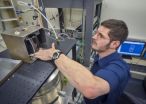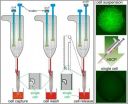(Press-News.org) Earth's magnetic field, a familiar directional indicator over long distances, is routinely probed in applications ranging from geology to archaeology. Now it has provided the basis for a technique which might, one day, be used to characterize the chemical composition of fluid mixtures in their native environments.
Researchers from the U.S. Department of Energy (DOE)'s Lawrence Berkeley National Laboratory (Berkeley Lab) conducted a proof-of-concept NMR experiment in which a mixture of hydrocarbons and water was analyzed using a high-sensitivity magnetometer and a magnetic field comparable to that of the Earth.
The work was conducted in the NMR laboratory of Alexander Pines, one of the world's foremost NMR authorities, as part of a long-standing collaboration with physicist Dmitry Budker at the University of California, Berkeley, along with colleagues at the National Institute of Standards and Technology (NIST). The work will be featured on the cover of Angewandte Chemie and is published in a paper titled "Ultra-Low-Field NMR Relaxation and Diffusion Measurements Using an Optical Magnetometer." The corresponding author is Paul Ganssle, who was a PhD student in Pines' lab at the time of the work.
"This fundamental research program seeks to answer a broad question: how can we sense the interior chemical and physical attributes of an object at a distance, without sampling it or encapsulating it?" says Vikram Bajaj, a principal investigator in Pines' group. "A particularly beautiful aspect of magnetic resonance is its ability to gently peer within intact objects, but it's tough to do that from far away."
The exquisite sensitivity of NMR for detecting chemical composition, and the spatial resolution which it can provide in medical applications, requires large and precise superconducting magnets. These magnets are expensive and immobile. Further, the sample of interest must be placed inside the magnet, such that the entire sample is exposed to a homogeneous magnetic field. This well-developed method is called high-field NMR. The sensitivity of high-field NMR is proportional to magnetic field strength.
But chemical characterization of objects that cannot be placed inside a magnet requires a different approach. In ex situ NMR measurements, the geometry of a typical high-field experiment is reversed such that the detector probes the sample surface, and the magnetic field is projected into the object. A main challenge with this situation is generating a homogeneous magnetic field over a sufficiently large sample area: it is not feasible to generate field strengths necessary to make conventional high-resolution NMR measurements.
Instead of a superconducting magnet, low-field NMR measurements may rely on Earth's magnetic field, given a sufficiently sensitive magnetometer.
"One nice thing about Earth's magnetic field is that it's very homogeneous," explains Ganssle. "The problem with its use in inductively-detected MRI [MRI – magnetic resonance imaging – is NMR's technological sibling] is that you need a magnetic field that's both strong and homogeneous, so you need to surround the whole subject with superconducting coils, which is not something that's possible in an application like oil-well logging."
"Sensitivity of magnetic resonance depends profoundly on the magnetic field, because the field causes the detected spins to align slightly," adds Bajaj. "The stronger the applied field, the stronger the signal, and the higher its frequency, which also contributes to the detection sensitivity."
Earth's magnetic field is indeed very weak, but optical magnetometers can serve as detectors for ultra-low-field NMR measurements in the ambient field alone without any permanent magnets. This means that ex-situ measurements lose chemical sensitivity due to field strength alone. But this method offers other advantages.
In high-field NMR, the chemical properties of a sample are determined from their resonance spectrum, but this is not possible without either extremely high fields or extremely long-lived coherent signals (neither of which are possible with permanent magnets). In contrast, relaxation and diffusion measurements in low-field NMR are more than sufficient to determine bulk materials properties.
"The approach at low-field, which you can achieve using permanent magnets or Earth's magnetic field, is to measure spin relaxation," explains Ganssle. Relaxation refers to the rate at which polarized spin returns to equilibrium, based on chemical and physical characteristics of the system. Additionally, NMR experiments resolve chemical compounds based on their different diffusion coefficients, which depend on the size and shape of the molecule.
A key difference between this and conventional experiments is that the relaxation and diffusion properties are resolved through optically-detected NMR, which operates sensitively even in low magnetic fields.
"A previous achievement of our collaboration has been the development of magnetometers for the detection of NMR," says Bajaj. "This experiment represents the first time magnetometers have been used to make combined relaxation and diffusion measurements of multicomponent mixtures."
Relaxation and/or diffusion measurements are already commonly used in the oil industry for underground NMR measurements, though conventional probes use a permanent magnet to increase the local magnetic field. There were attempts to perform oil well logging starting in the 1950s using the Earth's ambient field, but insufficient detection sensitivity led to the introduction of magnets, which are now ubiquitous in logging tools.
"What's novel here is that using magnetometers, we finally have technology that might be sensitive enough for efficient detection in the Earth's field, perhaps ultimately enabling detection at longer distances," explains Scott Seltzer, a co-author on the study.
The design was tested in the lab by measuring relaxation coefficients first for various hydrocarbons and water by themselves, then for a heterogeneous mixture, as well as in two-dimensional correlation experiments, using a magnetometer and an applied magnetic field representative of Earth's.
"This proof of concept might be productively applied in the oil industry," says Ganssle. "We mixed hydrocarbons and water, pre-polarized them with a magnet, and applied a magnetic field the same as the Earth's. Then we made measurements with our magnetometer and determined that we had easily enough sensitivity to separate components of oil and water based on their relaxation spectra."
This technology could help the oil industry to characterize fluids in rocks, because water relaxes at a different rate from oil. Other applications include measuring the content of water and oil flowing in a pipeline by measuring chemical composition with time, and inspecting the quality of foods and any kind of polymer curing process such as cement curing and drying.
The next step involves understanding the depth in a geological formation that could be imaged with this technology.
"Our next study will be tailored to that question," says Bajaj. "We hope that this technology will eventually peer a meter or more into the formation and elucidate the chemistry within."
Eventually, probes could be used to characterize entire borehole environments in this way, while current devices can only image inches deep. The combination of terrestrial magnetism and versatile sensing technology again offers an elegant solution.
INFORMATION:
Other authors on the Angewandte Chemie paper include Hyun Doug Shin, Micah Ledbetter, Dmitry Budker, Svenja Knappe, John Kitching, and Alexander Pines. The current publication presents some of the work for which Berkeley Lab won an R&D 100 award earlier this year on optically-detected oil well logging by MRI.
This research was supported by the U.S. Department of Energy's Office of Science.
Lawrence Berkeley National Laboratory addresses the world's most urgent scientific challenges by advancing sustainable energy, protecting human health, creating new materials, and revealing the origin and fate of the universe. Founded in 1931, Berkeley Lab's scientific expertise has been recognized with 13 Nobel prizes. The University of California manages Berkeley Lab for the U.S. Department of Energy's Office of Science. For more, visit http://www.lbl.gov.
DOE's Office of Science is the single largest supporter of basic research in the physical sciences in the United States, and is working to address some of the most pressing challenges of our time. For more information, please visit the Office of Science website at science.energy.gov.
NMR using Earth's magnetic field
Berkeley Lab researchers demonstrate ultra low-field nuclear magnetic resonance with an optical magnetometer
2014-08-19
ELSE PRESS RELEASES FROM THIS DATE:
Biomarker in an aggressive breast cancer is identified
2014-08-19
Two Northwestern University scientists have identified a biomarker strongly associated with basal-like breast cancer, a highly aggressive carcinoma that is resistant to many types of chemotherapy. The biomarker, a protein called STAT3, provides a smart target for new therapeutics designed to treat this often deadly cancer.
Using breast cancer patient data taken from The Cancer Genome Atlas, molecular biologists Curt M. Horvath and Robert W. Tell used powerful computational and bioinformatics techniques to detect patterns of gene expression in two cancer subtypes. They ...
Nurse staffing and mortality in stroke centers
2014-08-19
Hospital staffing levels have been associated with patient outcomes, but staffing on weekends has not been well studied, despite a recent UK mandate to make physician specialist care 7 days a week a policy and service improvement priority for the National Health Service. To help address the paucity of research on the association of weekend staffing with patient outcomes, Dr. Benjamin Bray of King's College London and Royal College of Physicians, United Kingdom, and colleagues conducted a prospective cohort study of weekend staffing with stroke specialist physicians for ...
Blood glucose levels measured in hospitalized patients can predict risk of type 2 diabetes
2014-08-19
Blood glucose levels measured in hospitalized adults during acute illness can be used to predict risk of developing type 2 diabetes over the following 3 years, according to a study published by David McAllister and colleagues from the University of Edinburgh, UK in this week's PLOS Medicine.
The researchers obtained measurements of blood glucose levels on admission for 86,634 patients aged 40 years or older who were admitted to a hospital for an acute illness between 2004 and 2008 in Scotland and identified those patients who developed type 2 diabetes up to December 2011 ...
Electrical engineers take major step toward photonic circuits
2014-08-19
Edmonton—The invention of fibre optics revolutionized the way we share information, allowing us to transmit data at volumes and speeds we'd only previously dreamed of.
Now, electrical engineering researchers at the University of Alberta in Edmonton, Alberta, Canada are breaking another barrier, designing nano-optical cables small enough to replace the copper wiring on computer chips.
This could result in radical increases in computing speeds and reduced energy use by electronic devices.
"We're already transmitting data from continent to continent using fibre optics, ...
New study first to examine quality of cardiac rehabilitation programs in Canada
2014-08-19
The quality of cardiac rehabilitation programs across Canada is strong, with specific criteria areas now identified as requiring further enhancement to improve patient outcomes, according to a new study conducted by researchers at the Peter Munk Cardiac Centre, York University and UHN.
"We are the first to comprehensively assess cardiac rehabilitation quality --- what we are doing well and where we should do better --- to this degree across the country," says Dr. Sherry Grace, study author, Director of Research, GoodLife Fitness Cardiovascular Rehabilitation Unit, University ...
Asian inventions dominate energy storage systems
2014-08-19
This news release is available in German. Wind and solar power are inherently intermittent energy sources. If a large amount of electricity is to be produced with renewable energy sources in the future, excess energy will have to be stored during productive periods so that these fluctuations can be compensated for. However, existing storage capacities are far from adequate for the purpose. Science and industry are therefore working on new, better technologies. One important focus lies on battery systems that used to be too expensive or unsophisticated to be employed ...
This week from AGU: Long-term ecological research, predicting cholera outbreaks
2014-08-19
From this week's Eos: Long-Term Ecological Research and Network-Level Science
Imagine if we had the ability to track how a wide range of ecosystems was responding to global changes in real time. Such a tool would be particularly powerful if it coupled multiple decades of information about ecological responses to environmental change with large-scale, long-term experiments and models from dozens of different ecosystem types.
In fact, this tool exists: It is the Long-Term Ecological Research (LTER) Network, which will soon celebrate its 35th anniversary.
From ...
Moving single cells around -- accurately and cheaply
2014-08-19
HOUSTON -- ( Aug. 19, 2014 ) -- Scientists at the Houston Methodist Research Institute have figured out how to pick up and transfer single cells using a pipette -- a common laboratory tool that's been tweaked slightly. They describe this engineering feat and preliminary test results in a recent issue of the Journal of the American Chemical Society.
"Studying single cells and their unique functions has become a frontier in current biomedical research," said nanomedicine department. faculty member Lidong Qin, Ph.D., the project's principal investigator. "One of the biggest ...
Financial weight makes it trickier to lose pounds where it counts
2014-08-19
This news release is available in French. Montreal, August 19, 2014 -- Weight-loss advertising tends to target people ready, willing and able to pay for diet programs, special meals or gym memberships. But it's those who live below the poverty line who are more likely to be overweight or obese.
When it comes to weight-loss for the poor, it turns out that it's more than just cash-flow that stands in the way. A new study in the American Journal of Preventive Medicine by researchers from Concordia University shows that those who struggle the most financially also are ...
Neighborhood ethnic composition and problem drinking among older Mexican-American men
2014-08-19
BATON ROUGE – LSU Sociology Professor Samuel Stroope is the lead author of a new study, "Neighborhood Ethnic Composition and Problem Drinking among Older Mexican American Men," that will appear in the Journal of Immigrant and Minority Health.
Stroope – and co-authors at Baylor University and the University of Texas Medical Branch – found that older Mexican-American men are less likely to engage in problem drinking as residents of neighborhoods with a higher proportion of Mexican-Americans. The study used data on 350 men aged 75 and older from the "Hispanic Established ...
LAST 30 PRESS RELEASES:
Engaging pharmacists to improve atrial fibrillation care
Exploring brain synchronization patterns during social interactions
Unveiling the molecular functions of lipid droplet proteins in Arabidopsis thaliana leaves
Perfecting the view on a crystal’s imperfection
Fossil frogs share their skincare secrets
Existing drugs studied in patients with rare immune diseases
Loma Linda University study reveals alarming rates of pediatric injuries from mechanical bull riding
Excessive pregnancy weight gain and substantial postpartum weight retention common in military health care beneficiaries
Odor-causing bacteria in armpits targeted using bacteriophage-derived lysin
Women’s heart disease is underdiagnosed, but new machine learning models can help solve this problem
Extracting high-purity gold from electrical and electronic waste
Tropical fish are invading Australian ocean water
No bull: How creating less-gassy cows could help fight climate change
ECU researchers call for enhanced research into common post-stroke condition
SharpeRatio@k: novel metric for evaluation of risk-return tradeoff in off-policy evaluation
$1.8M NIH grant will help researchers follow a virus on its path to the nucleus
Follow-up 50 years on finds landmark steroid study remains safe
Active military service may heighten women’s risk of having low birthweight babies
Significant global variation in national COVID-19 treatment guidelines
Cost increasingly important motive for quitting smoking for 1 in 4 adults in England
Is there an association between HPV vaccination and anti-NMDA receptor encephalitis?
Blood-based multi-omics guided detection of a precancerous pancreatic tumor
Eye-opener: Pupils enlarge when people focus on tasks
Current Nanomaterials and Current Analytical Chemistry have been indexed in Ei Compendex
International balance of power determined by Chinese control over emerging technologies, study shows
New writing therapy helps late-stage cancer patients face biggest fears
National Jewish Health researchers identify connection between air pollutants and allergic diseases
In the United States, the election of progressive prosecutors led to higher relative rates of property and overall crime, but not to higher relative rates of violent crime
European Court of Human Rights is “backsliding” on legal protections for asylum seekers, study says
Being treated by a female physician associated with lower risk for death
[Press-News.org] NMR using Earth's magnetic fieldBerkeley Lab researchers demonstrate ultra low-field nuclear magnetic resonance with an optical magnetometer



